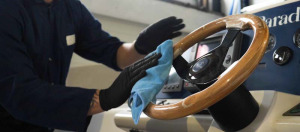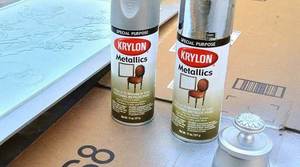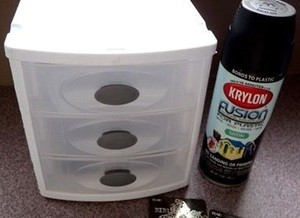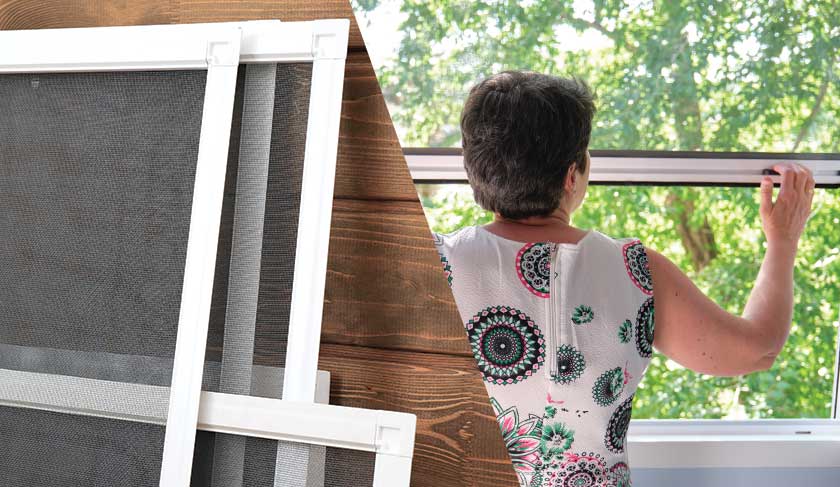After a day of painting, you’re probably wondering how on Earth to handle the mess of paint on your brushes and rollers. To make your task more manageable, Sara explains how to remove paint from a paintbrush step-by-step, and how to clean the paint roller head and handle.
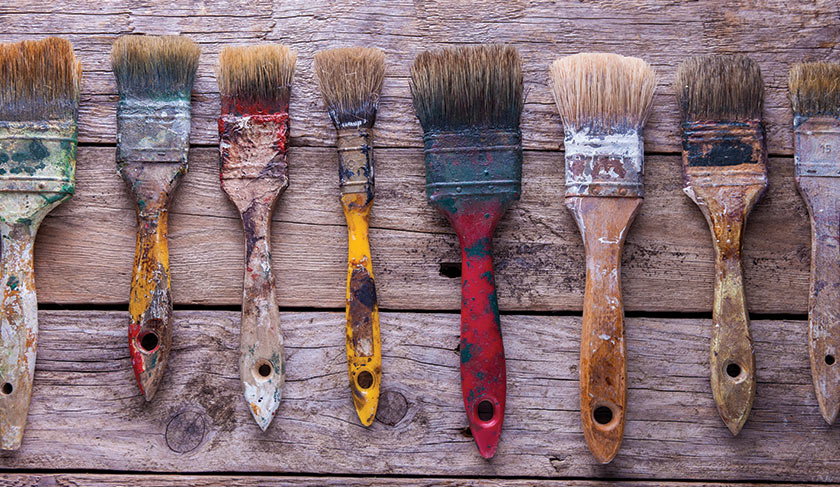
While studying my fine art degree, I spent most days painting with oil paints and acrylics. On the lucky days I could just wrap up the paint palette and brushes in some plastic wrap. On the other days, I had to clean up. After a full day of painting and creative energy exertion, dealing with cleaning brushes and tools was the last thing I wanted to do… usually I just wanted a glass of wine or sleep!
However, after years of cleaning fine art brushes and tools, I became very fast at doing it. Whether it is oil-based or water-based acrylic, whether art paints or house paints, the general principle for how to remove paint from a paintbrush and roller is the same.
The technique you use will depend on whether you used oil-based paint or water-based paint, and of course, whether you used a roller or paintbrush. I explain the steps for each technique below.
How to Remove Paint from a Paintbrush
High-quality paintbrushes are designed to last a long time if they are properly maintained. In order to ensure the longevity of your paintbrushes, you will need to clean them after every single use.
Water-based Paint: How to Remove Paint from a Paintbrush
Here is the fastest technique I have found for cleaning water-based paints off brushes. I’ve shared a few other techniques below, but after trying a few I have personally found this to be, for me, the fastest and best way to clean paint brushes used for water-based paints.
- Wipe the brushes until they are as clean as possible. Get a rag, piece of cardboard or newspaper and just start doing some abstract painting with the paint left on your brush. The idea is to wipe off as much paint as possible, before you start cleaning.
- Get a tub of water, and jiggle the brushes around in the water. Rub them gently against the side of the tub. This is the time to get as much paint off your brushes as possible. Since it is water-based, it should go into the water quite easily, but you will need to change the water a few times.
- Get some liquid soap and warm water – hand soap, dish soap or laundry soap is fine. Put a little bit of soap in the middle of your palm, add some warm water, and start rubbing the brush bristles gently against your hand. Then rinse off the painty soap. Repeat, until no more color comes off the brush bristles. You might need to do this 3-4 times.
- Air-dry the brushes. Put the brushes outdoors on a rack or old towel to dry. Set and forget, as they will take a while to dry.
How to Clean Oil Based Paint from Brush
Compared with cleaning water-based paint from brushes, cleaning oil-based paint from brushes is a real headache. While I was painting our house while I was pregnant, I actually developed the habit of buying cheaper paint brushes and roller heads that I could throw in the trash afterwards, because I couldn’t face cleaning them.
However, that is not the most environmentally-friendly way, and if you are using oil paints with good quality brushes, it is good to learn how to clean oil based paint from brush bristles. Below is the technique I developed to clean oil-based paint from brushes.
For this you will use solvent, so wear a mask and/or do this outside, because the fumes from solvents will kill your brain cells. It is seriously carcinogenic stuff, and hence why I don’t use oil-based paint anymore (because I decided my health is more important than paint).
- Wipe the brush until it is as clean as possible. Grab a piece of cardboard or newspaper, and start wiping it in all directions. The idea is to wipe off as much paint as possible, before you start cleaning. Keep wiping until you can’t see any more paint come off on the paper.
- Get a jar of solvent, such as mineral turpentine. Now start jiggling and wiping the brush around in the solvent and against the jar, to get as much off the brush as possible. Below are some tips.
- If you can, change the solvent when it gets really dirty, but it’s not necessary.
- Compared with water-based paints you will have to press down on the brushes a bit harder and do it longer. From personal experience, I have found that oil-based paints get stuck in the brush more than water-based, particularly up near the ferrule.
- While cleaning, try and gently separate the bristles and make sure the solvent goes right into the brush, especially near the ferrule.
- Wipe the brushes on scrap paper. Get a piece of newspaper, and wipe the brush to get as much of the solvent off as possible.
- Get some liquid soap and warm water (hand, dish or laundry soap). Put a spot of soap in your hand with some warm water, and start wiping and rubbing the brush bristles against your hand. Gently separate the bristles and get the soap right into the brush. Rinse, then repeat with more soap. Continue repeating with soap and rinsing until the water runs clean.
- Dry the brushes. Lay the brushes outside to dry, on an old towel or rack.
Extra Techniques & Tips for How to Remove Paint from a Paintbrush
Use Soapy Water
In order to properly clean a paintbrush, you will need warm water and some mild dish soap (or other liquid soap). While most homeowners or DIYers simply rinse their brushes out under the tap, this is not the best option, and paint is likely to remain trapped in the brush and ruin it once it dries.
Rather, in order to ensure the longevity of a paintbrush, it is important to use warm water and gently but thoroughly wash the bristles with mild dish soap. I personally find it helpful to rinse the brushes with plain water first, just to remove the excess paint off first, but always follow up with warm water and liquid soap afterwards.
A Scraper Will Help
There are many different types of scrapers that can be picked up at a local hardware store, but only one of them is specifically designed for cleaning paintbrushes. As discussed in this article from Purdy, good quality paintbrush scraper will not only help to remove paint from the bristles more quickly, but it will also help to dislodge any paint that has dried up near the ferrule. When you are washing out the brush in warm soapy water, make sure to run the scraper through the bristles in order to remove all of the paint particles.
Use a Paint Spinner
Some people even prefer using a paint spinner. These devices include a covered container where the brush is simply spun at high speeds in order to remove all the paint and water. In order to use a paint spinner, you will need to first rinse out your paintbrush in warm water, and then spin it at high speeds in order to remove any remaining paint or water.
Just make sure to cover the surrounding area to ensure that nothing gets spattered by flying paint. I personally hate paint spinners, because they seem to always make a mess for me, which then creates even more work in cleaning up and doesn’t seem to help whatsoever in making the cleaning task any easier.
Allow to Air Dry
Once you have finished cleaning the brushes, it’s important to completely air dry them before you reuse them or even store them away. One of the best habits that any homeowner or DIYer can form, is to keep the original cover that came with the brush when it was purchased and use that in order to help maintain the brush’s original form. Once the brush has completely dried in the air, return it back inside its container and hang it up neatly with the rest of your tools.
How to Clean the Paint Roller Head & Handle
Unlike paintbrushes, paint rollers can be quite difficult for the average homeowner or DIYer to clean. Nevertheless, a high-quality paint roller can last a long time if it’s properly maintained.
I’ll admit that I don’t keep roller heads, because they are a total pain in the ass to clean. Instead, I purchase middle-range roller heads that I can afford to discard, which I feel is ok since I do house painting infrequently these days. Throwing out 1-2 roller heads per year doesn’t seem like a huge issue for me personally, but if you are painting more frequently, then cleaning and saving your rollers makes sense.
Step 1: Use A Multi-Tool
First, use your paint roller scraper and multi-tool to thoroughly scrape the paint off the roller as a start. If the paint is still in good condition, you can scrape it off straight into the tin. You’d be surprised how much paint you can save from doing this.
What on Earth is that, you ask?
You will find a wide variety of putty knives and scrapers at your local hardware store. For painting, there is a specially designed scraper and multitool that has a half-moon cutout on one side of the blade. This multitool was specifically designed to help painters to scrape off any excess paint from the roller back into the paint can in order to reuse it later.
Since rollers tend to absorb a lot of paint, it only makes sense to save as much paint as possible before you begin washing it out. You can also use this tool to scrape paint from windows and even open up paint cans. This article from Spruce has more detail on these tools, that you can check out, or you can simply go to your local hardware store and see them for yourself.
If you can’t get to the shop, a homemade trick is to get a heavy-duty, sturdy piece of wire a few inches long (make sure it is heavy-duty, like fencing wire). Loop it into a hoop a little bigger than your roller head. Loop the wire around the base of the roller, pull it tight, then pull it to the other end of the roller head. The wire will scrape up the paint as it gets dragged along the roller head.
Step 2: Wipe the Roller on Paper or Cardboard
Like cleaning paint brushes, simply roll the roller head over and over on some paper or cardboard until you have gotten as much paint off as possible. This will make the next steps much easier and cleaner.
Step 3: Remove the Roller Head
Next, you want to remove the roller from the frame itself. Although it is tempting to leave the roller on the frame, and simply run it under the water, this can cause the roller to spin and send paint and water splattering everywhere.
With the roller removed from the frame, just like a paintbrush, you will want to wash it with mild dish soap in warm water. You need to make sure that it is thoroughly rinsed out because any remaining soap residue can result in suds forming during your next painting project.
Oil-based paint: If you have a roller head with oil-based paint on it, I would personally suggest cleaning it with a bit of solvent, before you start cleaning it with soap and water. Put on some gloves, and get an old rag. Pour some mineral spirits on the rag, then simply rub, squeeze and wipe the roller head with it. It doesn’t have to be perfect, but it will get quite a bit of hidden paint off.
Step 4: Let It Air Dry
As always, make sure that you let the roller completely dry out hair before you put it away. While many rollers come with a plastic tube, there are still a wide variety of options that feature paper tubes. You should make a habit of standing the roll up on its end, to ensure that it does not flatten out while drying. Once it has completely dried out, you can return it to a plastic bag and put it with the rest of your painting equipment.
Step 5: Clean the Frame
Don’t forget to also clean the frame. It’s so unsightly seeing a perfectly good frame that stops functioning because the paint dries up near the roller support. When this happens, the frame stops rolling properly and makes it very difficult to roll the brush smoothly over the surface. Take the time to scrape off any paint residue using a sturdy scrub brush, and make sure to use plenty of warm soapy water. Once it’s done make sure to rinse out the frame and let it air dry before packing it away for future use.
Final Thoughts on How to Remove Paint from a Paint Brush and Roller
I hope you’ve found this a useful and practical guide to cleaning up your brushes and roller after painting. While cleaning up may be the last thing you want to think about after a full day of painting, it is a necessary step to keep your tools in good shape.
While I would recommend getting into a habit of cleaning up on the same day, if you find yourself in a situation where you truly don’t have the energy to clean up afterwards (let’s say, it’s 10pm at night), then you actually can leave it to the next day.
To do this, make sure you wrap up your paint tools (brush, roller, tray etc) in plastic – either plastic wrap or a plastic bag – to ensure it doesn’t dry out. If you do this, it will last a few days, so if you really need to put off your cleaning until tomorrow you have that option.
Happy painting!
Author
-

Hey, I’m Sara, co-owner of NestKoo! I’m a graphic designer and professionally trained fine artist, with a Bachelor of Arts (Fine Art) majoring in Painting. I love being close to nature, sustainable living and bringing new life to old things. My specialty in NestKoo is DIY house painting, upholstery and furniture upcycling, where I bring my skills in fine art painting and contemporary design together into a practical home DIY context.
View all posts

